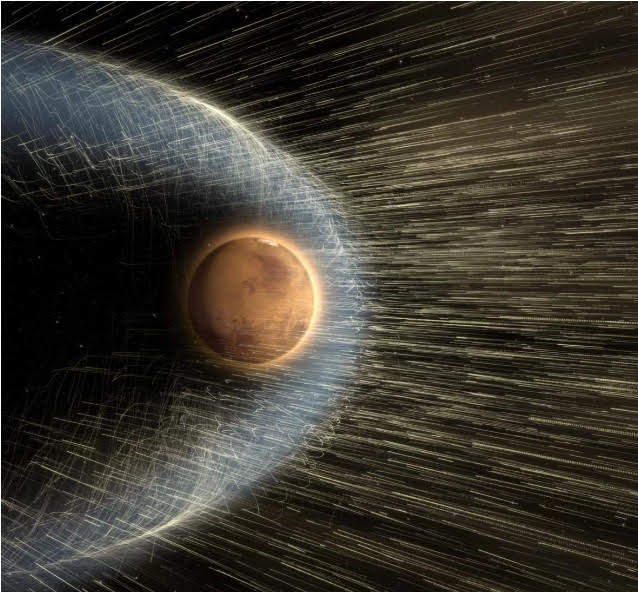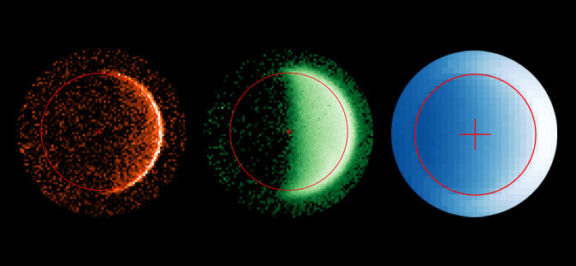NASA’s MAVEN (Mars Atmosphere and Volatile Evolution) mission has identified the process that appears to have played a key role in the transition of the Martian climate from an early, warm and wet environment that might have supported surface life to the cold, arid planet Mars is today.

The Mars we now know have features from the other extreme end of the spectrum. So how did Mars become this chill and desert permeated planet over the years? Well a simple explanation would be the loss of Mars’s atmosphere; yes Mars lost its entire atmosphere.

The Earth has a magnetic field that protects us from the Sun, funneling harmful high-energy particles (known as solar wind) away from the planet that would otherwise strip our atmosphere away.
How Mars lost its atmosphere?

But Mars on the other hand doesn’t have a magnetic field, so the solar wind strikes its atmosphere directly, knocking atoms off into space.
The disappearance of the Martian atmosphere must have led to the complete evaporation of water. The reason behind the red planet’s atmosphere is something that has been bugging the scientists and various other space enthusiasts.
MAVEN data have enabled researchers to determine the rate at which the Martian atmosphere currently is losing gas to space via stripping by the solar wind. The findings reveal that the erosion of Mars atmosphere increases significantly during solar storms. The scientific results from the mission appear in the Nov. 5,2015 issues of the journals Science and Geophysical Research Letters.
NASA’s MAVEN which was launched on November 18, 2013 had only one mission and that was to find the answer to the ever unsettling question: “WHAT HAPPENED TO THE MARTIAN ATMOSPHERE”
MAVEN is NASA’s multi-decade and an unprecedented Mars Exploration Program sent out to extensively study and understand Mars and to find out whether or not life in Mars is at all possible or to conclude if it was sustainable to host life many years ago.
MAVEN made great progress right from the initial weeks. It observed oxygen, carbon and hydrogen escaping from the planet’s atmosphere into space. These atoms were once part of carbon dioxide and water vapor molecules near the surface.
MAVEN initially started studying mars by creating a global wind map of the planet’s upper atmosphere, a first for any planet other than Earth. It has also watched huge clouds spanning hundreds of kilometres form in a matter of hours.
The Martian orbit is more elliptical (oval) than the earth’s orbit, hence Mars come much closer to the sun at some point. MAVEN found out that there’s a heavy loss of particles and gasses from the atmosphere when it is closer to the Sun.
By studying further, MAVEN established the main culprit behind the disappearance of the Martian atmosphere- the Sun. The hot and highly energetic particle (collectively known as solar wind) emitted by the Sun hits the atmosphere, which is unprotected.
This high speed solar winds bombards with the particles in the Martian atmosphere, giving it enough power and velocity to pull away from the atmosphere.
Weighing about 2,500 kilograms, MAVEN is equipped with variety of instruments to study Mars.
However the highlight of the spacecraft is its flagship Imaging Ultraviolet Spectrograph, or IUVS, a camera capable of capturing ultraviolet light.

This helps MAVEN measure gases leaving Mars’s atmosphere, since they reflect and scatter ultraviolet light.
5 years after reaching the Martian orbit, MAVEN’s orbit was lowered so that it can relay data between Earth and NASA’s recently launches Mars 2020 mission.
MAVEN has enough fuel to see it through the 2030’s, so it will be increasingly tasked with replacing communication relay responsibilities of aging orbiters like NASA’s Mars Reconnaissance Orbiter and Odyssey spacecraft. While not conducting relay communications, MAVEN will continue to study Mars’s atmosphere.
Additional Resources:
